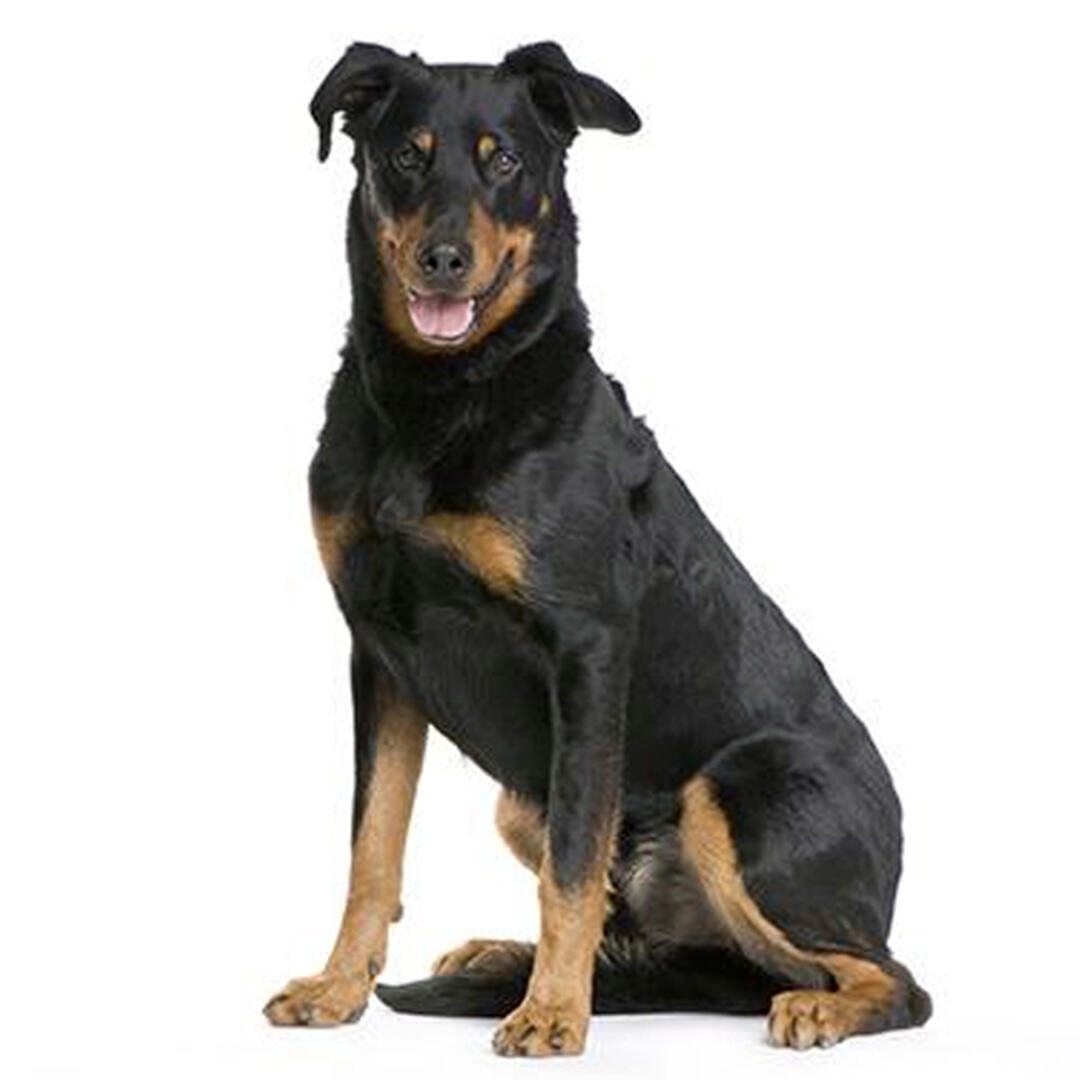
| Family-friendly: | 3/5 |
| Exercise needs: | 5/5 |
| Easy to train: | 4/5 |
| Tolerates being alone: | 1/5 |
| Likes other pets: | 3/5 |
| Energy level: | 5/5 |
| Grooming needs: | 4/5 |
| Shedding: | 5/5 |
The Beauceron breed can be prone to:
- Hip dysplasia
- Gastric dilitation volvulus
- Osteochondrosis dissecans
Priority Kennel Club health schemes and testing:
- Hip dysplasia screening scheme
Bold, courageous and quick to learn, the Beauceron is a people dog and a working dog. They dislike being left alone too long and benefit greatly from having a job to do. Strong willed and capable of independent decision making, the Beauceron is not suited to first time dog owners, but will excel with those who enjoy training and canine sports. Naturally a little suspicious of strangers due to their livestock guardian history, they will benefit from early and thorough socialisation and habituation to people and household life.
| Family-friendly: | 3/5 |
| Exercise needs: | 5/5 |
| Easy to train: | 4/5 |
| Tolerates being alone: | 1/5 |
| Likes other pets: | 3/5 |
| Energy level: | 5/5 |
| Grooming needs: | 4/5 |
| Shedding: | 5/5 |
Originating from the Beauce region of France, the Beauceron became a popular livestock herding and guarding breed throughout most of the north of the country. Thought to be closely related to the long-coated Briard and one of the founding breeds of the Doberman Pinscher, the Beauceron is the largest of the French sheepdogs. Also know as the ‘Bas Rouge’ (Red Stockings) because of their rich red coat markings, the Beauceron was used in the World Wars for multiple jobs including guarding, carrying messages and supplies and for land mine detection.
The breed is so closely related to the Briard that it wasn’t until 1893 that veterinarian Paul Megnin differentiated between the long-haired Berger de Brie (Briard) and the short haired Berger de Beauce (Beauceron) and the Club des Amis du Beauceron was formed in 1922. The UK breed club wasn’t formed until 2009, and it was not until July 2014 that the breed was moved off the Import Register and formally recognised as a Pastoral Breed by the UK Kennel Club.
Very much the experienced dog-sports enthusiast’s dog, unless you can provide a farm or small holding and livestock to move and guard. The Beauceron is not far from their original working roots, and needs to be worked and be with their owner most of the day. Rural owners with teenage children or child-free families, who have the time to put into socialisation and training are best.
This is still a working dog, with lots of energy and a clever, independent mind. Two hours exercise per day, with plenty of additional training and mental stimulation, is needed for the adult Beauceron.
As their history as a working dog suggests, they do well at a variety of canine sports and competitions, although they may find the busy atmosphere of competition over-stimulating if not well socialised. They thrive when spending most of their time engaged with their human family, doing something together.
This is a big dog that likes to spend a lot of time outdoors, so the home should be able to accommodate those needs. A secure garden is essential as these are large, athletic animals easily capable of jumping or climbing insubstantial fencing. Access to interesting and varied local walks will help keep your Beauceron entertained, and while in the right house and with the right management they can live almost anywhere with enough space, they are likely to do better living in the country or very close to it.
Large breed dogs, as well as having large appetites, benefit from a different balance of nutrients including minerals and vitamins compared to smaller-breed dogs.
The short, thick coat is about 3-4cm long, quite coarse and lies close to the body. The coat is shorter on the head and a little longer at the back of the thigh and under the tail – an area that could tangle if neglected. Brush through the Beauceron's coat two or three times a week. Like several French shepherd breeds, the Beauceron has a large double dewclaw on each hindleg which should be checked regularly, together with the rest of the nails.
Easily trained using positive, modern methods, the Beauceron can turn a paw to any activity you’d care to try, including agility, man-trailing, Rally, Canicross, obedience, and much more. Careful attention should be paid to teaching a good recall and care should be taken around livestock. Early socialisation with other family pets, visitors and children is vital. This is a dog for someone who enjoys exercise and training in their own right, rather than as a means to a quiet dog!
The Beauceron is excellent with their own family but this is a large dog who as a puppy is likely to be clumsy and boisterous. They may also be suspicious of visitors. This in conjunction with the amount of exercise and training they require is likely to mean they are not suited to very busy families or those with younger children.
While many dogs are traditionally thought of as being good with children, all dogs and children need to be taught to get on with and respect each other, and be safe together. Even so, dogs and young children should never be left alone together and adults should supervise all interactions between them.